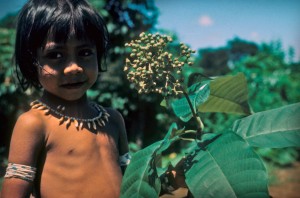Climate Change Threatens Indigenous People in Amazon
Posted in Science on August 20 2009, by Plant Talk
Garden Scientist Studies “Culturally Keystone Species”
 |
Brian M. Boom, Ph.D., is Director of the Caribbean Biodiversity Program at The New York Botanical Garden. |
Add one more item to the long list of threats that indigenous peoples around the world have to their cultural survival: global warming.
 In the past, when the climate changed, indigenous groups could usually migrate to areas where the climate was suitable for their ways of life. Now, with indigenous groups often restricted to territories that are surrounded by farms, ranches, and settlements of more populous and powerful non-indigenous peoples, there is usually no where for them to go. They must endure the climatic changes by adapting; if they cannot adapt, their cultures may become extinct.
In the past, when the climate changed, indigenous groups could usually migrate to areas where the climate was suitable for their ways of life. Now, with indigenous groups often restricted to territories that are surrounded by farms, ranches, and settlements of more populous and powerful non-indigenous peoples, there is usually no where for them to go. They must endure the climatic changes by adapting; if they cannot adapt, their cultures may become extinct.
While the general problem of climate change to indigenous groups is global, it is also occurring in the Amazon, an area I have studied. A recent New York Times article reported that a drier, hotter Amazonia due to deforestation and climate change is killing off the fauna and flora that indigenous groups of the region depend on for their survival. And I have some data that bear on elucidating the gravity of this issue.
In the 1980s, I teamed up with fellow botanist Ghillean Prance and anthropologists William Balée and Robert Carneiro on a comparative ethnobotanical project with the goal of quantifying the use of trees by four indigenous Amazonian groups. We published the results of our studies in 1987 in the journal Conservation Biology (vol. 1, no. 4) under the title “Quantitative Ethnobotany and the Case for Conservation in Amazonia.” Our main general finding was that these groups had specific cultural uses for between about 50% to more than 75% of the tree species in their territories. This result illustrates just how tightly dependent native Amazonians are on their environment for cultural survival.
Further, we found that the four groups studied each had uses for what we termed “non-substitutable” species of tree: those species for which the particular groups had no alternative source for a useful product such as food, fuel, or medicine. Such species are what I now term “culturally keystone species,” because they provide the only source for a cultural need for an indigenous group. For example, the Ka’apor know only one species that provides an oil used to repel black flies; the Chácobo value the trunks of one tree species to carve mortars and troughs in which they pound maize grains into meal; the Tembé have one species that yields an oil to alleviate the pain of earaches; and the Panare (see photo of Panare boy) have access to only one species that provides durable leaf thatch for their house roofs.
As traditional links with their environment are increasingly broken as a result of global warming, already highly threatened cultures in Amazonia and elsewhere are at least as endangered with extinction as are the plants and animals upon which these peoples depend for survival.

